| |
 
HISTORY ON THE
DOORSTEP
History programmes are amongst the post popular
on our TV screens, with millions watching Simon
Scharma’s History of Britain, David Starkey
on the Tudors and Richard Holmes, the guru of the
battlefield. Yet a visit to some of our local
churches, a glance at a few monuments and a
little detective work will bring history alive
much nearer home, as I hope the following four
examples will show.
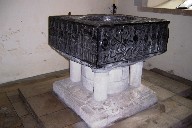 |
|
First to East
Meon, where the elaborate Norman tower
has dominated the village for nine
hundred years. Its greatest treasure is a
black marble font, one of just seven in
the kingdom. Unlike the others, this is
not a monument but a testament to Henry
of Blois, Bishop of Winchester from 1129
to 1171. He was the brother of King
Stephen and the grandson of William the
Conqueror, and as Chancellor of England
one of the most important men in the
realm. He was responsible for the
building of the Bishop’s Palace at
Bishops Waltham, the Hospital of St.
Cross at Winchester and Farnham Castle,
as well as being Lord of the Manor of
East Meon. |
He had a reputation for
beautifying his churches, and hence four of these
black marble fonts are in Hampshire. The others
are at Winchester Cathedral, St. Michael’s,
Southampton and St. Mary Bourne, near Andover,
and were brought to England from Tournai, in
Belgium, in about 1150. The East Meon font is
vividly carved with the story of Adam and Eve,
with Eve displaying a very conspicuous fig leaf!
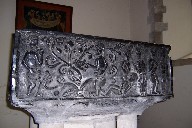 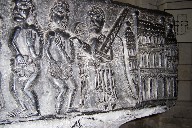
A few miles east of
Petersfield stands the somewhat barn-like church
of St. George at Trotton, where the interior is
full of treasures. The west wall is covered with
mediaeval paintings, but it is for two famous
monumental brasses that the church is best known.
On the floor of the nave, beneath a red carpet,
we find the earliest brass commemorating a woman
anywhere in the country.
| It is Margaret de
Camoys, who died in 1310. She is depicted
wearing a wimple and a veil, giving her
face a triangular appearance. Her husband
later fought at the Battle of
Bannockburn, and three of their sons
fought at Crécy in 1346. Her grandson, Lord Thomas
Camoys, was responsible for the famous
bridge over the river at Trotton and
commanded the left wing at the Battle of
Agincourt. His magnificent brass, in
which he is shown with his wife,
Elizabeth, surmounts a huge table tomb in
front of the altar. He is wearing full
armour, holding his wife’s hand,
with the Order of the Garter below his
left knee. With their military background
it seems not unreasonable that the male
line of the Camoys family had died out by
1450.
|
|
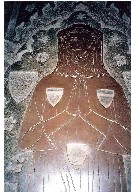 |
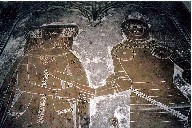 |
|
Next let us look
inside the fine church at South Harting,
conspicuous beneath its green spire.
Hidden away in the south transept is the
battered effigy of Sir Richard Caryll,
who died in 1616. The Carylls were a Catholic
family who owned land throughout Sussex,
and despite their faith built a mortuary
chapel adjoining the chancel of Harting
Church, which seems to be an unusually
early example of ecumenism.
|
| In 1689 the family
built a mansion at Ladyholt, across the
valley from Uppark, of which not a stone
remains. It was here that the Carylls
entertained most of the great literary
figures of the eighteenth century, until
it was sold and demolished before 1770. The Caryll Chapel fell into
disrepair and has also been demolished,
but Sir Richard’s effigy was brought
into the church in 1956, the only
memorial of a once influential family.
|
|
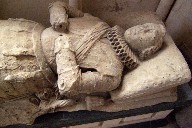 |
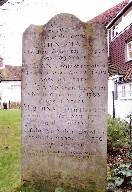 |
|
Finally to
Petersfield itself, to look at the one
headstone left standing when St.
Peter’s churchyard was levelled in
1950. Just to the right of the gate, it
commemorates the great John Small, the
most famous of the Hambledon cricketers
who beat the all-England XI in 1774 and
1777. He was the second of five John
Smalls, who traded from premises facing
the Square. Originally a shoemaker, he
also made cricket equipment, supplying
bats, balls and breeches to the club.
Contemporary accounts say that he was the
finest batsman of his day, and a fielder
without equal. Indeed, he was a fine
all-round sportsman, excelling at
hunting, shooting and ice-skating. He was also an accomplished
musician, and for an amazing seventy-five
years played the fiddle and the cello in
the Petersfield Choir, in the days when
singers and instrumentalists ruled the
roost from the West Gallery, many of them
immortalized in Thomas Hardy’s novel
Under the Greenwood Tree.
|
He died on the last day of
1826, aged eighty-nine, and is buried with his
wife and three daughters who all died in
childhood. His epitaph reads: “Praises on
tombs are trifles vainly spent; a man’s good
name is his own monument.”
Tom Muckley, October 2003
This article was originally
published by the
Petersfield Post
tommuckley.co.uk
|
|








